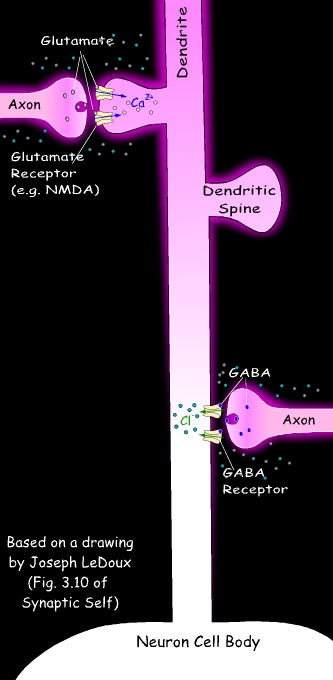 I'm currently reading Joseph LeDoux's excellent book "Synaptic Self" - I highly recommend it. Chapter 3 of the book - "The Most Unaccountable Machinery" - does a splendid job of covering the basic working mechanisms of neurons, axons, dendrites and synapses, as well as the history behind some of the most important discoveries in neurobiology. The section covering inhibition was particularly enlightening for me, so I'd like to use this post to capture the key points on inhibition and the roles of Glutamate and GABA.
I'm currently reading Joseph LeDoux's excellent book "Synaptic Self" - I highly recommend it. Chapter 3 of the book - "The Most Unaccountable Machinery" - does a splendid job of covering the basic working mechanisms of neurons, axons, dendrites and synapses, as well as the history behind some of the most important discoveries in neurobiology. The section covering inhibition was particularly enlightening for me, so I'd like to use this post to capture the key points on inhibition and the roles of Glutamate and GABA.In a previous post (Neurotransmitters - molecular messages), the following definition of GABA was quoted from another excellent (and free!) book: "Discovering the Brain" by Sandra Ackerman: GABA (gamma-aminobutyric acid) often acts as a fast synaptic transmission inhibitor. Unlike dopamine or serotonin, which have diverse roles, GABA consistently acts as an “off” signal; the cerebellum, retina, and spinal cord all use this transmitter to inhibit signals, as do many other parts of the brain and nervous system. GABA's inhibitory effect comes about in the following way: the transmitter opens a channel in the membrane through which negatively charged chloride ions can enter the cell. This influx hyperpolarizes the cell and makes it less likely to be excited by incoming stimuli. GABA receptor sites show some tendency to bind barbiturates and the “minor tranquilizers,” the benzodiazepines. Curiously, the presence of GABA in low concentrations enhances the binding of benzodiazepines to receptor sites. This pattern indicates that GABA and the benzodiazepines cannot be competing for exactly the same sites. Instead, an array of recent studies have yielded the view that the GABA receptor site is in fact a multifunctional set of proteins that contain the chloride ion channel and distinct subsites for binding of benzodiazepines, other tranquilizers such as barbiturates, and GABA itself.
Unlike GABA, Glutamate (the 'G' in MSG) is an excitatory neurotransmitter. Dr. LeDoux refers to Glutamate and GABA as "The Chemical Brothers" (hence this post's title :) )

From Synaptic Self: Inhibition is a very useful device in neural circuits. It adds termendously to the specificity of information processing, filtering out random excitatory inputs, preventing them from triggering activity. Only if the excitatory inputs arrive simultaneously can they overcome the inhibition and elicit activity. And once activity is elicited, inhibition is important for keeping the excitation in check and resetting the circuit.
From Wikipedia: GABA acts by binding to specific receptors in the plasma membrane of both pre- and postsynaptic cells. This binding causes the opening of ion channels to allow either the flow of negatively-charged chloride ions into or positively-charged potassium ions out of the cell. This will typically result in a negative change in the transmembrane potential.
Three general classes of GABA receptor are known. These include GABAA and GABAC ionotropic receptors, which are ion channels themselves, and GABAB metabotropic receptors, which are G protein-coupled receptors that open ion channels via intermediaries
From The Synaptic Self:Glutamate receptors (such as the NMDA receptor) tend to be located out on the dendrites, especially in the spines, whereas GABA receptors tend to be found on the cell body, or on the part of dendrites close to the cell body. In order for glutamate-mediated excitation to reach the cell body to help trigger an action potential, it has to get past the GABA guard. Excitation coming down a dendrite and headed for the cell body can be extinguished by GABA.
Without GABA inhibition, neurons would send out action potentials continuously under the influence of glutamate, and would eventually literally fire themselves to death. ... Overactivity of glutamate, and the resulting injury to neurons, actually plays an important role in stroke and other vascular disorders of the brain, as well as in epilepsy and possibly Alzheimer's disease.
Comments